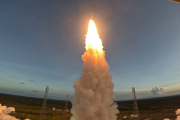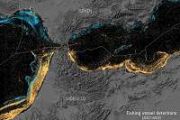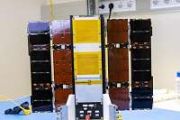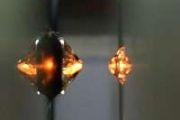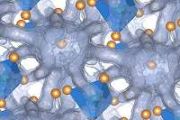
Copernical Team
2024: a year of launches
 Video:
00:06:06
Video:
00:06:06
As 2024 kicks into gear, we invite you to look ahead with ESA and see what awaits us in the coming 12 months.
After Ariane 5’s retirement in 2023, Europe’s new and versatile heavy-duty launcher Ariane 6 will continue the Ariane legacy of excellence and reliability. After years of development and construction,Ariane 6 will be ready for its first flight from Europe’s Spaceport in Kourou.
In 2024, we’ll see a return-to-flight for Vega-C. Vega-C will continue to provide Europe with its own affordable lightweight launcher. Together both projects guarantee Europe’s independent access to space.
We also continue to collaborate internationally with NASA on the Artemis lunar programme. This
The Challenge of Joint Space Operations
 For the United States and its allies and partners, using space to obtain an information advantage is a key aspect of joint operations. The joint force uses space operations to understand the battlespace, exercise command and control (C2), and conduct joint integrated fires. For decades, the United States has enjoyed a significant operational advantage in space, but China is challenging that.
For the United States and its allies and partners, using space to obtain an information advantage is a key aspect of joint operations. The joint force uses space operations to understand the battlespace, exercise command and control (C2), and conduct joint integrated fires. For decades, the United States has enjoyed a significant operational advantage in space, but China is challenging that. 'Explosive' Quadrantids meteor shower heading into peak
 The annual Quadrantids meteor shower is expected to peak early Thursday, dazzling viewers where cloud cover allows across the United States.
The Quadrantids is one of the best and most active meteor showers with up to 120 meteors every hour, NASA says. The meteors travel at a velocity of 25.5 miles per second and are most active from Dec. 26 through Jan. 18.
The peak this year is
The annual Quadrantids meteor shower is expected to peak early Thursday, dazzling viewers where cloud cover allows across the United States.
The Quadrantids is one of the best and most active meteor showers with up to 120 meteors every hour, NASA says. The meteors travel at a velocity of 25.5 miles per second and are most active from Dec. 26 through Jan. 18.
The peak this year is Ovzon 3 Satellite Launched Aboard SpaceX's Veteran Falcon 9 to Geosynchronous Orbit
 In a landmark event for space exploration and communications technology, SpaceX has successfully launched the Ovzon 3 mission to geosynchronous transfer orbit. The launch, conducted from Space Launch Complex 40 (SLC-40) at Cape Canaveral Space Force Station in Florida, took place on Wednesday, January 3, with a precisely timed 10-minute launch window that opened at 6:04 p.m. ET. A backup opportu
In a landmark event for space exploration and communications technology, SpaceX has successfully launched the Ovzon 3 mission to geosynchronous transfer orbit. The launch, conducted from Space Launch Complex 40 (SLC-40) at Cape Canaveral Space Force Station in Florida, took place on Wednesday, January 3, with a precisely timed 10-minute launch window that opened at 6:04 p.m. ET. A backup opportu FAST All Sky HI Survey Achieves Major Milestone in Extragalactic Astronomy
 The field of extragalactic astronomy has witnessed a significant advancement with the FAST All Sky HI survey (FASHI), a project designed to utilize the unique capabilities of the Five-hundred-meter Aperture Spherical radio Telescope (FAST). This ambitious survey, spanning an impressive 22000 square degrees of the sky, aims to revolutionize our understanding of the universe's HI content and its l
The field of extragalactic astronomy has witnessed a significant advancement with the FAST All Sky HI survey (FASHI), a project designed to utilize the unique capabilities of the Five-hundred-meter Aperture Spherical radio Telescope (FAST). This ambitious survey, spanning an impressive 22000 square degrees of the sky, aims to revolutionize our understanding of the universe's HI content and its l Astrobotic Readies for Historic Lunar Mission with Ansys Technology
 In a significant advancement for lunar exploration, Astrobotic is set to embark on one of the first Commercial Lunar Payload Services (CLPS) deliveries to the Moon, utilizing Ansys' (NASDAQ: ANSS) sophisticated simulation solutions. The Peregrine lunar lander, scheduled for a January launch and February landing, will transport 20 payloads from seven countries, aiding NASA's Artemis program in pr
In a significant advancement for lunar exploration, Astrobotic is set to embark on one of the first Commercial Lunar Payload Services (CLPS) deliveries to the Moon, utilizing Ansys' (NASDAQ: ANSS) sophisticated simulation solutions. The Peregrine lunar lander, scheduled for a January launch and February landing, will transport 20 payloads from seven countries, aiding NASA's Artemis program in pr First Batch of Starlink Satellites for Direct-to-Cell Service Launched by SpaceX
 In a significant leap for mobile connectivity, SpaceX's Falcon 9 rocket has successfully launched the first set of Starlink satellites equipped with Direct to Cell capabilities, as reported by T-Mobile. This launch, part of the livestreamed event last night, marks a pivotal step in the Coverage Above and Beyond initiative, a joint venture between T-Mobile and SpaceX. This ambitious project aims
In a significant leap for mobile connectivity, SpaceX's Falcon 9 rocket has successfully launched the first set of Starlink satellites equipped with Direct to Cell capabilities, as reported by T-Mobile. This launch, part of the livestreamed event last night, marks a pivotal step in the Coverage Above and Beyond initiative, a joint venture between T-Mobile and SpaceX. This ambitious project aims Sols 4056-4058 Blog: "Ringing" in a New Year
 Earth planning date: Tuesday, January 2, 2024: Curiosity was busy over the holiday break, working independently through 11 pre-planned sols. As Earth transitioned into a new year, dawn broke once again on Mars, and Curiosity awaited a call in the form of a fresh set of instructions. The return to planning for Curiosity's science team today was not immune to plot twists and suspense.
While
Earth planning date: Tuesday, January 2, 2024: Curiosity was busy over the holiday break, working independently through 11 pre-planned sols. As Earth transitioned into a new year, dawn broke once again on Mars, and Curiosity awaited a call in the form of a fresh set of instructions. The return to planning for Curiosity's science team today was not immune to plot twists and suspense.
While Privatised Moon landings: A new era of commercial lunar exploration
 Two commercial spacecraft are scheduled to launch to the Moon early in 2024 under a Nasa initiative called the Commercial Lunar Payload Service CLPS. This programme is intended to kickstart a commercial transportation service that can deliver Nasa experiments and other payloads to the lunar surface.
If successful, these missions will represent the first landings on the Moon by spacecraft d
Two commercial spacecraft are scheduled to launch to the Moon early in 2024 under a Nasa initiative called the Commercial Lunar Payload Service CLPS. This programme is intended to kickstart a commercial transportation service that can deliver Nasa experiments and other payloads to the lunar surface.
If successful, these missions will represent the first landings on the Moon by spacecraft d 30 Doradus B: NASA Telescopes Start the Year With a Double Bang
 A colorful, festive image shows different types of light containing the remains of not one, but at least two, exploded stars. This supernova remnant is known as 30 Doradus B (30 Dor B for short) and is part of a larger region of space where stars have been continuously forming for the past 8 to 10 million years. It is a complex landscape of dark clouds of gas, young stars, high-energy shocks, an
A colorful, festive image shows different types of light containing the remains of not one, but at least two, exploded stars. This supernova remnant is known as 30 Doradus B (30 Dor B for short) and is part of a larger region of space where stars have been continuously forming for the past 8 to 10 million years. It is a complex landscape of dark clouds of gas, young stars, high-energy shocks, an 


